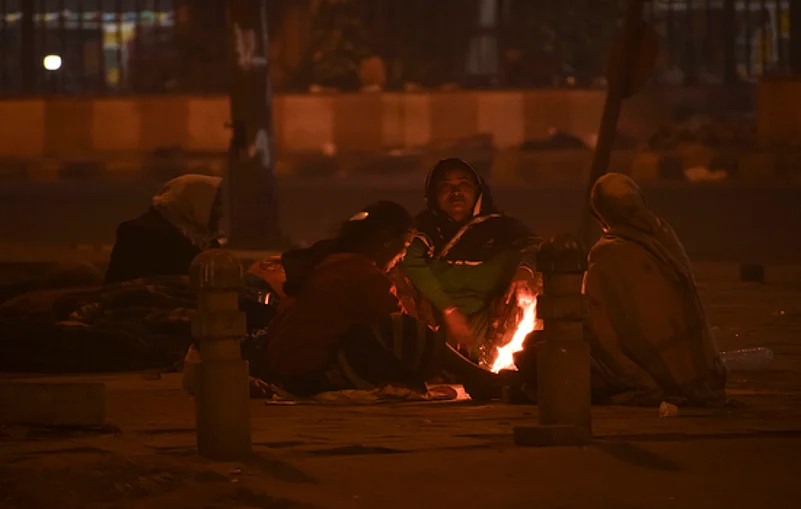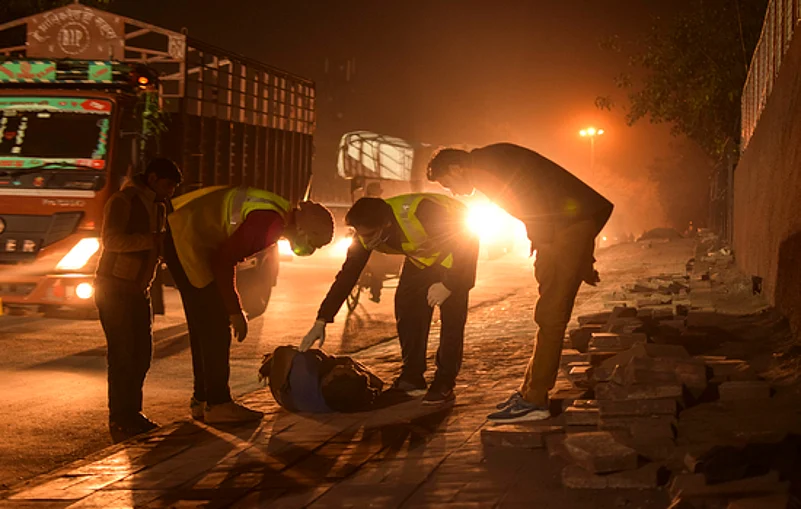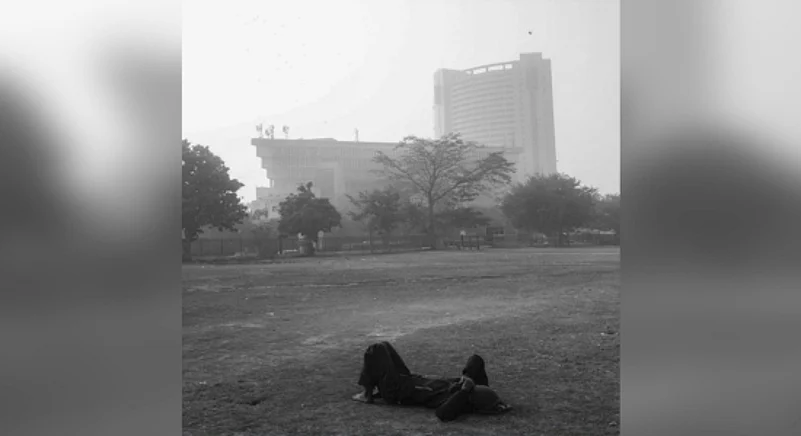US President Donald Trump talks of shooting migrants in the legs. India builds its first detention centre for “illegal immigrants.” Greece plans to deport 10,000 migrants. Britain is moving ahead with plans to “end the free movement of people once and for all.” Amidst such headlines, Pope Francis has decried the world’s indifference in the face of a global migration and refugee crisis on the World Day of Migrants and Refugees, October 1.
Without Home, Without Roots And Without Food: New Research Shows Alarming Rates Of Acute Malnutrition Among Migrants, Refugees and The Homeless
With a photo essay by Usha Ramesh and Vivek Tripathi to celebrate The World Day of Migrants and Refugees

Hungry and malnourished
The suffering of migrants, especially human rights abuses like rape, violence, exploitation and forced labour, have been in the news. But there has been little focus on the interface between migration and nutrition. Recently, Doctors Without Borders (MSF) has published a report on the “alarming rates of acute malnutrition” and lack of food in Libyan migrant camps, where children suffer especially badly. In India, a study led by Aajeevika in 2015 pointed to high levels of malnourishment among children whose parents migrate in search of livelihood: more than half the children were found to be underweight, stunted and wasted in communities of Rajasthan where migration was high. This year, research on migrant tribal communities of Rajasthan and Madhya Pradesh by nonprofit, Action Against Hunger, has shown an “epidemic of malnutrition”: 44 per cent of children under-5 stunted, 45 per cent underweight and 27 per cent wasted.
Unfriendly paradox
India is the top source of immigrants across the globe, with 17.5 million international migrants in 2019, yet ranks last in internal migration rates, reports the United Nations Department of Economic and Social Affairs. According to scholars, Indian cities are growing through internal migration. Migrants form the backbone of India’s development story: textile and construction sectors would grind to a halt without migrant labour. Internal migration improves household socio-economic status and benefits both the region that people migrate to and where they migrate from, shows research by World Bank economist Gaurav Nayyar (“India's internal labor migration paradox : the statistical and the real,” 2018).
India, however, suffers from acute disregard of its domestic migrants. Although the Constitution guarantees all citizens the fundamental right to move freely, reside and settle in any part of India, there is no wholesome migration policy framework at the Centre or the states for them. Kerala, not surprisingly, is the only state with the most migrant-friendly policies, shows the Interstate Migrant Policy Index 2019 (IMPEX 2019), compiled by nonprofit India Migration Now. As in Mumbai and Assam, the “original” residents frequently resist migrant welfare and integration.
Delhi’s underbelly
The capital has one of the highest share of inter-state migrants in its population: 40 per cent (or more than 63 lakh) people in Delhi are migrants, almost half being from Uttar Pradesh. A large chunk of Delhi migrants are poor, unskilled or semiskilled, artisanal rural population. They are forced to settle in extreme unhygienic clusters, called jhuggi-jhopri, at railway stations, bus terminus and wholesale markets as also on construction sites.
Today more than half the population of Delhi live in jhuggi-jhopri clusters, slums, designated areas, resettlement colonies, unauthorised and recently authorised colonies—none of which are ideal or health-friendly. Half of the children in the slums of Delhi are underweight, according to a study by CRY-Child Rights and You. It was in July, 2018, that the starvation deaths of three minor girls in east Delhi’s Mandawali brought to light the troubling, if unanswered questions, on the lives of low-income migrants arriving in big cities in search of better opportunity.
When Migrants Matter
Two of Outlook photographers, Usha Ramesh and Vivek Tripathi, have been going around in their leisure hours, camera in hand, and obsessively capturing the lives of people living on the streets of Delhi. The migrants, the vagrants and the homeless, excluded from civic systems, uprooted from known way of life, divorced from state benefits, humiliated at every turn and suffering from chronic hunger. Photography, to them, is more than taking pictures. It is taking stories.
PHOTO ESSAY: MIGRANTS MATTER
Photos by Usha Ramesh and Vivek Tripathi
Text by Vivek Tripathi

?(Photograph By: Vivek Tripathi)
Being homeless is difficult enough when the weather is fair, but when the temperature drops, it becomes a matter of survival. Most of the city’s poor are migrants they constitute about 33% of the population of Delhi, who come to the city attracted by the promise of a secure livelihood and better life. But their hopes and dreams are, more often than not fulfilled.

(Photograph By: Usha Ramesh)
Ram Veer a 47-yr-old man migrated from Bihar. Had stepped in the Capital as a teenage boy hunting for a better life for his family, but has barely managed to survive himself from the odd jobs and even have to beg sometimes. “We get food from a nearby temple usually khichdi. Night shelters provide us with blankets and that is enough for us. Whatever money I make from the odd jobs is enough to sustain myself on the streets” he says.

(Photograph By: Vivek Tripathi)
A couple sleeps off outside in a cold evening near a metro station in New Delhi.

(Photograph By: Usha Ramesh)
A homeless woman preparing food under a flyover bridge near Nizamuddin station of New Delhi, is one of at least 10,000 homeless women in India’s capital, where thousands of people arrive every day from villages and small towns, looking for a better life.?

(Photograph By: Vivek Tripathi)
Homeless women especially the ones who are not living along with their families suffer the worst kinds of violence and insecurity and are vulnerable to sexual abuse, exploitation, and trafficking. Many of these women have left abusive marriages, suffered sexual violence, or have been abandoned by families after the death of their husbands.

(Photograph By: Usha Ramesh)
Shabena, a woman caretaker on a late night duty, inside an all-women night shelter located near Jama Masjid in Delhi.

(Photograph By: Usha Ramesh)
A small child sleeping on a cart outside under a night bulb on a cold night at Chandni Chowk in New Delhi.

(Photograph By: Usha Ramesh)
A group of homeless children posing for a picture under a flyover near Sarae Kale Khan in Delhi.

(Photograph By: Vivek Tripathi)

?(Photograph By: Vivek Tripathi)
Arzina, A 5-yr- old girl is no different than many of children living under the bridge or a footpath in the country’s capital. Her family used to live in a slum area in Khushro Park near Nizamuddin railway station before the government forcefully evacuated the entire area in 2017. Since then they have no roof on their heads. Her dream is to become a police officer and bring justice to all homeless families in the city.
Advertisement

(Photograph By: Usha Ramesh)

(Photograph By: Vivek Tripathi)
A family walks late night outside in the chilling weather of Delhi carrying belongings on their head looking for a shelter near New Delhi railway station.

(Photograph By: Vivek Tripathi)
Rescue teams helping in shifting the homeless people from the roadside streets to the government provided night shelters for homeless men and women.

?(Photograph By: Vivek Tripathi)
Homeless people living on the streets refuse to come inside the night shelters regardless of the harsh weather conditions outside in the winters in New Delhi. The reluctance shown by the homeless people to shift to night shelters stems from a set of reasons such as unhygienic conditions, fear of theft and lack of proper space.
Advertisement

(Photograph By: Vivek Tripathi)
A homeless man being rescued by the DUSIB team after being found on a roadside street of Old Delhi.

(Photograph By: Usha Ramesh)
Men are being shifted to the night shelters provided by the Delhi government for the homeless people who have been sleeping outside in the night.

(Photograph By: Vivek Tripathi)

(Photograph By: Usha Ramesh)
A man sleeps inside a temporary night shelter after being rescued from an area near to Delhi Gate in New Delhi.?

(Photograph By: Usha Ramesh)
Homeless children sleep inside a family night shelter after being rescued from an area near the Red Fort in New Delhi.
Advertisement

(Photograph By: Usha Ramesh)
Homeless men sitting outside the Kashmere gate night shelter near ISBT in New Delhi.

(Photograph By: Usha Ramesh)
Food and tea are being distributed by a Gurudwara Sangh to the homeless men from night shelters at Kashmere Gate in New Delhi.

(Photograph By: Usha Ramesh)

(Photograph By: Usha Ramesh)
Children having food inside a night shelter for homeless families near Jama Masjid in Delhi.

(Photograph By: Vivek Tripathi)
Young girls sitting in a class inside a homeless family shelter, Various NGOs take regular classes for these homeless children in night shelters.

(Photograph By: Vivek Tripathi)

(Photograph By: Usha Ramesh)
Advertisement
The migrants are part of a global story of people in developing countries who are steadily moving out of their homes for survival as agricultural incomes and livelihoods shrink and land becomes economically unviable. The main reasons which drive people to urban areas are poverty and unemployment fearing which they run to save their lives.. Many do not even remember when they actually came to the capital to earn a living, but the one reality they live with every day is that they still do not have a place to call their own in this huge city.
-
Previous Story
 Priyanka Chopra Says Guneet Monga's 'The Elephant Whisperers' Is A Trunk-Filled With Emotions
Priyanka Chopra Says Guneet Monga's 'The Elephant Whisperers' Is A Trunk-Filled With Emotions - Next Story


















